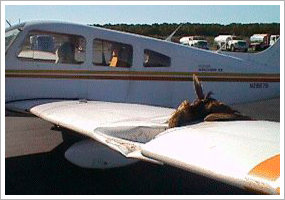| The following stories from the November 6, 2009, edition of AOPA ePilot were provided to AOPA members who expressed an interest in the particular subject areas. Any AOPA member can receive information tailored to their areas of interest by updating their preferences online. - My ePilot -- Helicopter Interest -Helicopter Association’s Salute to Excellence deadline extendedThe Helicopter Association International (HAI) announced that the 2010 Salute to Excellence Awards call for nominations deadline has been extended to Nov. 12, 2009. HAI members and nonmembers will now have more time to submit nominations and signed acknowledgement forms for one or more of the nine awards. Read more >>
TRAINING TIPsDon’t BASH a bird
Where are conflicts with birds likely? “The altitudes of migrating birds vary with winds aloft, weather fronts, terrain elevations, cloud conditions, and other environmental variables. While over 90 percent of the reported bird strikes occur at or below 3,000 feet agl, strikes at higher altitudes are common during migration. Ducks and geese are frequently observed up to 7,000 feet agl and pilots are cautioned to minimize en route flying at lower altitudes during migration,” says an excerpt from the treatment of the subject in the Aeronautical Information Manual .
Migratory birds aren’t the only hazard. There’s risk all year. If an airport frequently has birds present or in the vicinity, that fact may be noted in its listing in the Airport/Facility Directory. For example, the airport remarks for the Greater Cumberland Regional Airport in Maryland contain this shorthand entry: “Deer/birds on and invof arpt.” Notices to airmen (notams) may also alert pilots to wildlife and bird activity.
Researching an airport with military aircraft on the field, you may see a “BASH” notice about increased bird activity. This refers to the military’s Bird Aircraft Strike Hazard Prevention Program.
BASH was discussed in the AOPA Flight Training article “ Avoiding bird strikes,” which also gives eight tips for avoiding encounters of the feathered kind. For example, you may know that landfills attract gulls. Did you know that they may circle a landfill as high as 1,000 feet agl? The article also describes the three major migratory U.S. flyways, and adds a caution: “While the major flyways are the birds' primary routes, numerous smaller routes exist throughout much of the country. Rivers, for example, are often migratory routes.”
If you are flying in a hot zone for bird activity, slow down and turn on aircraft lights. If you do experience a bird strike, fly the airplane! Later, tell the FAA about your encounter using the Bird/Other Wildlife Strike Report form. TRAINING PRODUCTSScreen protectors from Pilotmall.comComputer screens are magnets, it seems, for oily fingerprints and scratches. So, too, are the screens in cockpit and portable GPS units. Keep things clean with screen protectors for the Garmin 296, 396, or 496, available from Pilotmall.com. The plastic screens, which sell for $16.99, are anti-reflective and removable. Order online or call 800/249-5730.
Note: Products listed have not been evaluated by ePilot editors unless otherwise noted. AOPA assumes no responsibility for products or services listed or for claims or actions by manufacturers or vendors. FINAL EXAMQuestion: I have been making good progress in my private pilot training. Unfortunately, I seem to have a bad case of mic fright and usually jumble the radio calls. Does AOPA have any tips or advice to help me sound more like a seasoned aviator and less like a student pilot?
Answer: The AOPA Air Safety Foundation has developed a new, free interactive course to help you make better radio calls. Say It Right: Mastering Radio Communications is available online.
Got a question for our technical services staff? E-mail [email protected] or call the Pilot Information Center, 800/872-2672. Don’t forget the online archive of "Final Exam" questions and answers, searchable by keyword or topic. |
 The autumn bird migration is in full swing. Seasonal reporting programs and some spectacular news events make pilots aware that a bird-strike hazard exists. Especially now, it behooves pilots to assess the risk of colliding with a bird on any route of flight.
The autumn bird migration is in full swing. Seasonal reporting programs and some spectacular news events make pilots aware that a bird-strike hazard exists. Especially now, it behooves pilots to assess the risk of colliding with a bird on any route of flight.

